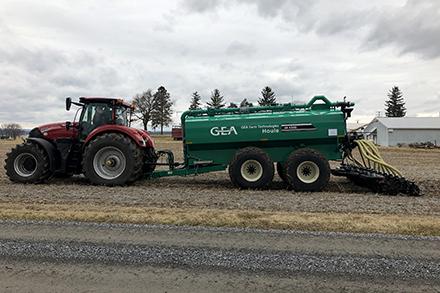A Manure Maneuver

A new manure applicator design places manure below the soil surface to reduce volatile emissions and runoff of nutrients. (ARS Pasture Systems and Watershed Management Research Unit, D4907-1)
ARS scientists are employing manure to help dairy farmers tackle climate change.
The effects of climate change are bringing new and increasingly complex challenges to agriculture.
One problem is the exacerbation of nutrient pollution. Higher temperatures can increase undesirable gaseous losses arising from applied fertilizers, and more intense or frequent severe storms can cause more fertilizer runoff losses. The issue is particularly concerning for dairy farmers in the northeastern United States; although dairy is one of the most important agricultural operations in the area, it also faces strict regulation and a reputation by some for being environmentally unfriendly. Increasing pollution only worsens that reputation.
As a result, dairy farmers urgently need environmentally sustainable solutions, explained Alan Rotz, an agricultural engineer with the ARS Pasture Systems and Watershed Management Research Unit in University Park, PA.
Together with Penn State University collaborators, Rotz evaluates novel practices aiming to limit manure-derived nutrient loss and runoff from farms. One such practice involves combining double-cropping with something a little funkier: subsurface manure injection.
“Animal manure can be a great source of fertilizer-rich nutrients for crops. Traditionally, farmers broadcast or spread manure across the soil surface of their fields as fertilizer,” said Rotz. “But with this technique, special tools are used to place the manure directly into the soil instead.”

A shallow disk tool places the manure into the soil with minimal disturbance of the soil surface. (ARS Pasture Systems and Watershed Management Research Unit D4908-1)
Injecting manure is a relatively new technology that incorporates manure into fields with minimal soil disturbance. Although the technique requires specialized equipment and is slower than simply spreading manure onto the surface of fields, Rotz believes that the pros outweigh the cons. With the manure injection method, farmers can reduce ammonia gas emissions from manure, decrease overall surface nutrient runoff, and even minimize air pollution caused by unwanted odors.
At the Pennsylvania dairy farm chosen to host his research, Rotz and his team also double-cropped winter rye and corn, harvesting the crop in the spring and preserving it as silage for animal feed. By doing so, they kept the soil on the farm continuously covered by vegetation, thus increasing forage production, reducing feed costs for dairy cows, and improving nutrient-use efficiency.
To ensure the long-term practicality of their findings, Rotz used a computer model (called the Integrated Farm System Model) to simulate over 25 years of both historical and projected future weather conditions for the region. Rotz and his team ultimately found that double-cropping with subsurface manure injection reduced total nitrogen losses by 12-18 percent, and total phosphorus losses by 16-19 percent.
Tactics like subsurface manure injection help dairy farmers adapt to both stricter regulations and the impacts of climate change. Though their results are specific to dairy farms in central Pennsylvania, Rotz and his team hope their research will lead to future breakthroughs that help dairy and other agricultural industries adapt to climate change across the nation and beyond. – by Georgia Jiang, ARS Office of Communications.

